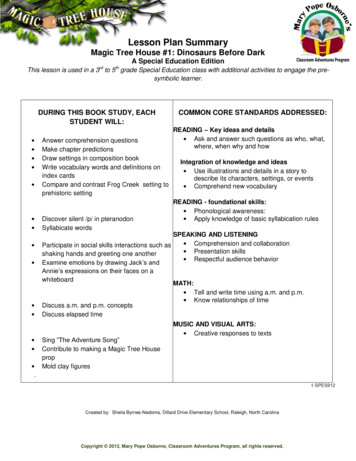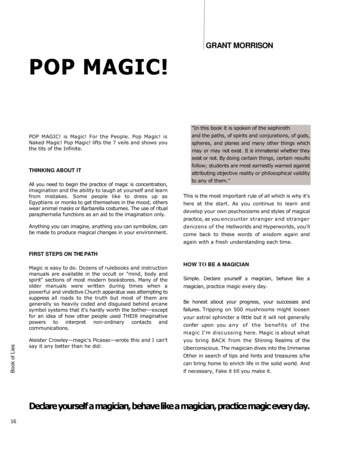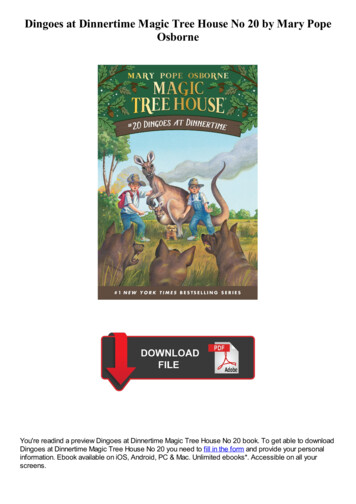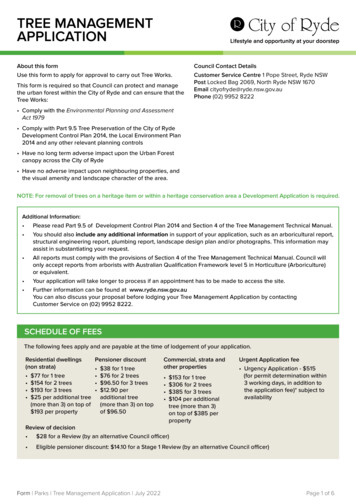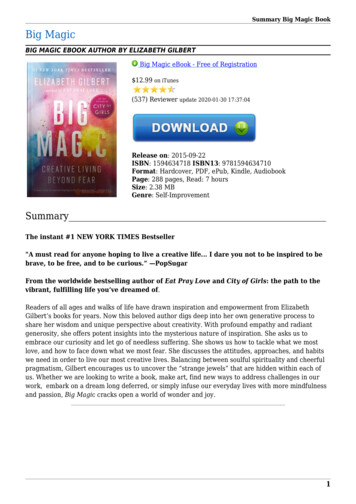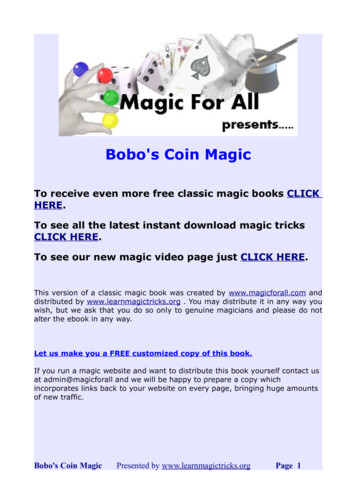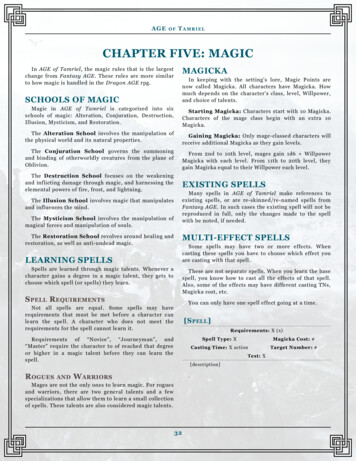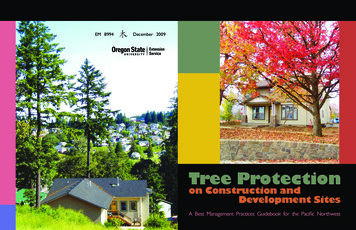
Transcription
Lesson Plan SummaryMagic Tree House #16: Hour of the OlympicsLet the Games Begin! THIS EXTENTION WILL ENABLE EACHCHILD TO:!Learn facts about Ancient Greece and thefirst Olympic games.Compare and contrast Modern dayOlympics to the Ancient Olympics.Discover the meaning of the symbol for theModern Olympics.Gain an appreciation for the spirit ofcompetition and sportsmanship and howthe ancient Olympic games formed thefoundation for these values.Plan and engage in friendly competitionwith classmates in a class Olympics.COMMON CORE STANDARDS ADDRESSED:Reading: Write information to examine a topic Compare and contrast findings presentedin a text Identify reasons an author gives to supportpoints in a text Summarize a written text for informationSocial Studies: Historical comprehension Chronological thinkingPhysical Education: Demonstrate a mature form in mostlocomotor movements. Demonstrate qualities of movement with apartner. Create a movement sequence. Demonstrate positive response tochallenges (good sportsmanship).16-1S112Created By: Paula Henson 2007 Magic Tree House Teacher of the Year Knoxville, TNCopyright2012, Mary Pope Osborne Classroom Adventures, all rights reserved.
Lesson PlanMagic Tree House #16: Hour of the OlympicsOlympics Then and NowIn Hour of the Olympics and the accompanying Fact Tracker Ancient Greece and theOlympics, students learn that the Olympics began in Ancient Greece as a festival to honorZeus, the ruler of all the other Greek gods, in 776 BC. They were an important part of Greeklife and lasted 1,170 years until Greece lost its power. The games came to an end for manyyears until the first modern Olympics took place in Greece in 1896.The Olympics remain an important part of our culture as well as that of many other nations.The Olympic spirit still remains as do many other important factors established in the earlyyears of the Olympic Games. However, life has changed and evolved over the years, whichhave brought about differences in the Olympics of Ancient Greece and the modern Olympicsof today. Remind your students that in Hour of the Olympics, Annie was not allowed to attendthe games, much less compete, because she was a girl! Mary Pope Osborne and NataliePope Boyce note the similarities and differences of the Ancient and Modern day Olympics inthe final chapter of the Fact Tracker, Ancient Greece and the Olympics.Students are familiar with the practice of comparing and contrasting topics on a Venndiagram. Customize this idea by allowing your students to use the familiar five Olympic rings(as seen on page 104 of the Fact Tracker) to compare and contrast Ancient and Modern dayOlympics. Ask them to complete the “Olympics Then and Now” activity sheet (provided). Inthe four spaces where the rings intersect, ask students to find four similarities of Ancient andModern day Olympics. In the five spaces where the rings do not intersect, ask students towrite five differences between the two.Next, ask your students to color the Olympics rings as they appear on the Olympic flag. Theofficial symbol of the Olympic Games is composed of five interlocking rings, colored blue,yellow, black, green, and red on a white field. The colors of the rings represent the flags of thecountries that participate in the Olympics. Every flag of a country participating in the Olympicscolors.includes one of thoseFinally, follow up with a fun culminating activity: “Let the Games Begin!” Allow your class toparticipate in their own Ancient Olympic Games! Here are a few suggestions: Finally,16-1Created By: Paula Henson 2007 Magic Tree House Teacher of the Year Knoxville, TNCopyright2012, Mary Pope Osborne Classroom Adventures, all rights reserved.112
Let the Games Begin! Divide your class into cooperative groups of four. Tell the teams that they represent Greekcity-states and that they will be competing in games similar to the games athletescompeted in during the earliest Olympics that they read about in Hour of the Olympicsand Ancient Greece and the Olympics. They can choose one of the following Greek citystates to represent.1)Athenians, 2)Spartans, 3)Corinthians, 4)Megarians, or 5)Argives Each of the team members will be competing in one of the first three events and all fourwill take part in the last event as a team effort – chariot races. The events should be heldin a gym. Be sure to remind the children they learned that the word gymnasium comesfrom the Greek word meaning “to exercise naked”!! But assure them that they will bewearing Greek togas! Make togas out of large white trash bags: Cut arm holes in the sides and a large hole inthe bottom of the bags for the child’s head. Tie around the waist with a “sash” (a piece ofcloth or jute rope). Togas can also be made in the same fashion out of king size pillowcases (if resources are available). These “togas” can be stored for use with futureclasses. Allow each city-state to design their own flag being sure to use colors that appear in theOlympic rings. Team captains will carry the flag and lead their “delegation” in a line to thegym. Students can repeat an oath to be good sports and play fairly just as Olympians did in theancient Olympics and as Modern Olympians still do today:The Olympic Oath"In the name of all competitors, I promise that we shall take part in theseOlympic Games, respecting and abiding by the rules that govern them, in the true spirit ofsportsmanship, for the glory of sport and the honor of our teams."
Have four ancient Olympic Games for competition. The games listed below are describedin the Fact Tracker, Ancient Greece and the Olympics, but other games of your choicecould be substituted. Set up four stations in the gym ahead of time. Parent volunteerswill be needed for this event. One parent per game is advisable. All four will be neededfor the chariot race.1. Discus – (Frisbee) – Provide a Frisbee and an open space in the gym for competition.You will need a measuring device to determine who threw the “discus” the greatestdistance.2. Javelin – Provide a child’s foam spear for throwing and an open space in the gym. (Onecan be made using a “noodle” pool toy.) A measuring device will be needed to determinedistance.3. Stade (foot race) – Remind students that the Greek word stade is where we get the wordstadium in the English language. There were several different stades in the ancientgames, but the most difficult was the one in full armor. Allow your students to compete inthis race by wearing “armor” consisting of a football helmet and a metal trash can lid for ashield! Plastic lids would also work. You will need one of each for each runner. Theyshould run the length of the gym. Use a timer to determine each runner’s time.4. “Chariot Race” – In the ancient games, we learn (in the Fact Tracker) that chariot raceswere a popular event. Remind students that a magic chariot rescued Jack and Annie inthe book Hour of the Olympics. Although you cannot organize a chariot race similar tothose used in the ancient Olympics, you can play a version of the game with groups ofchildren. This game must be played on a smooth floor and would not be suitable as anoutside game. Give each group an old, large blanket or quilt, and ask them to line up atthe starting line. Have one child (driver) from each team sit in the center of the blanket.The other children each hold one corner of the blanket while the “driver” holds onto theother corner sitting backwards in the middle of the blanket. On the word "Go," therunners holding the blanket run across the gym, trying to beat the other teams to thefinish line while the driver in the middle holds on. If the driver falls off, the team must stopuntil the child is back in position. This game will take up a great deal of space as eachteam will race at the same time the full length of the gym.Runner 1!!!!!!!!!!!!!!!!!!!!!!!!!!!!!!!!!!!"# %&#!!!!!!!!!!!!!!!!!!!!!!!!!!!!!!!!!!!!!'()*! (#,&#! ,!-,*!.()*/Runner 3Runner 2Finish Line
Drivers sit backwards in the middle, fold the “free” corner in toward them, and hold on!The first chariot team across the finish line is the winning team. Of course, close adultsupervision will be required for this activity to ensure safety. At the end of the games. Have a victory ceremony for each event. The winners willreceive a wreath of olive branches for their head as the athletes did in AncientGreece! These can be made by cutting and gluing paper olive leaves on the rim ofa paper plate with the center of the plate cut out. The winning chariot team will needa wreath for each member. Follow team leaders with flags back to the classroom in a closing ceremony paradecomplete with music and cheering!Here are some of the comparisons that your students might note after reading thebooks to complete the “Olympics Then and Now” activity sheet: Differences (to be noted in the parts of the Olympic rings that DO NOT intersect)Students may use phrases rather than complete sentences to conserve space: Modern day Olympics are a sporting event only and do not honor the Greek gods asthe Ancient Olympics did. Olympics are now held in different countries – not just in Greece as Ancient Olympicswere. Modern Olympics are not just for men and boys. Women and girls play a big parttoday. We have the summer and winter games today, not just summer games as in theAncient Olympics. Champions in Ancient Greece were crowned with an Olive wreath. Modern dayOlympians receive medals of gold, silver, and bronze. Similarities (to be noted in the parts of the Olympic rings that DO intersect)Encourage students to use words or phrases to save space: Both Ancient and Modern day Olympians devote years to training. Modern and Ancient Olympians both took an oath to play fair and obey rules. In both Ancient and Modern Olympics athletes promise to be good sports and do theirbest. There are no chariots in Modern day Olympics but there are races involving horses. There are still foot races, javelin, discus, boxing, long jump, and the pentathlon inModern day Olympics.
Olympics Then and NowName:After reading Hour of the Olympics and the Fact Tracker Ancient Greece and the Olympics, you will discoverthat there are similarities and differences between the Olympic games of Ancient Greece and those of today.The Modern Olympic symbol is five interlocking rings whose colors represent the flags of all the countries thatparticipate in the Olympics. The colors are from left to right, blue, yellow, black, green, and red. Color therings and write in the spaces that DO NOT intersect the differences between the Olympic games of AncientGreece and the games of today. Next, write in the four areas that DO intersect the similarities that existbetween the Ancient games and the Olympics we know today.Copyright2012, Mary Pope Osborne Classroom Adventures, all rights reserved.
Magic Tree House #16: Hour of the Olympics , Let the Games Begin! Divide your class into cooperative groups of four. Tell the teams that they represent Greek city-states and that they will be competing in games similar to the games athletes competed in during the earliest Olympics that they read about inHour of the Olympics ,

